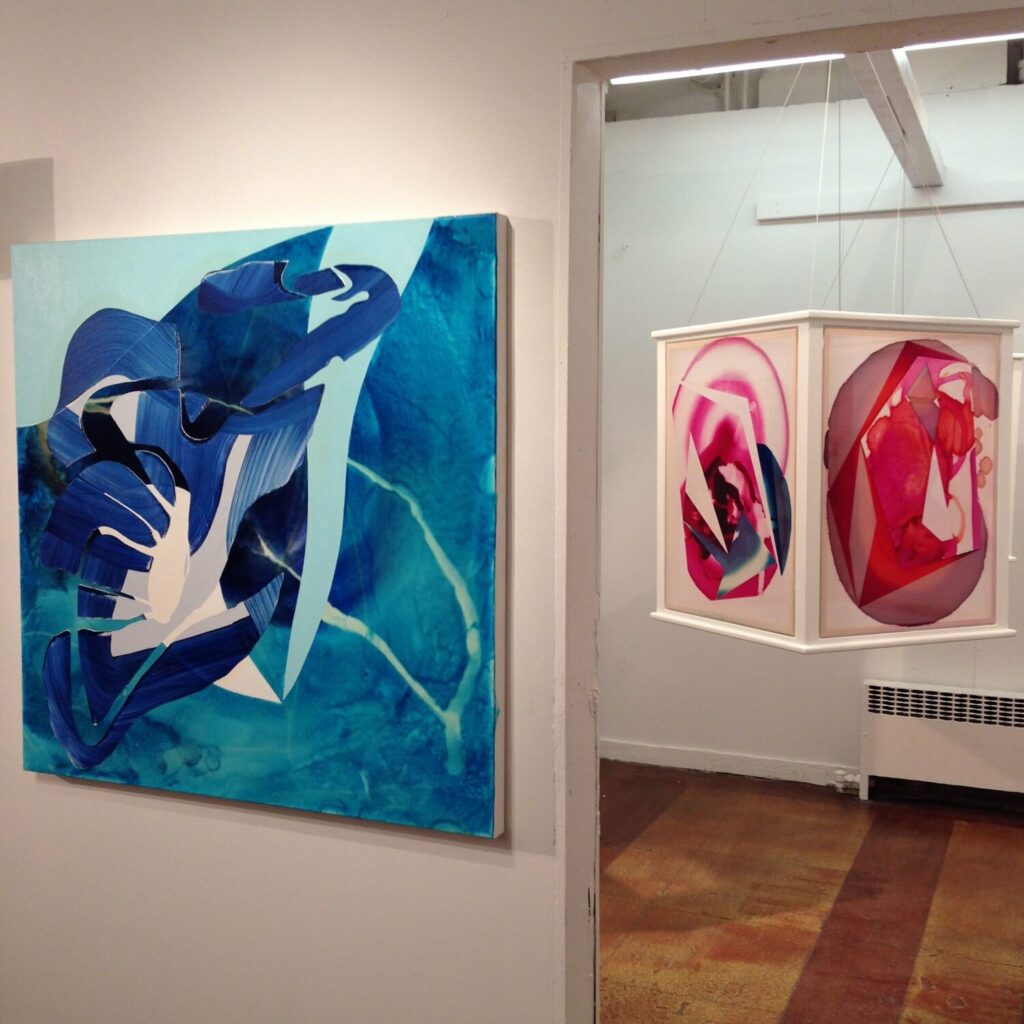Richard Jacobs: Soul Delay

The work of Richard Jacobs reaches us slowly. For many years, this Yale MFA graduate has painted in the seclusion of his Vermont studio. Although Jacobs’s paintings immediately reference the urgency of AbEx gestures and even Arp’s early chance collages, there is an indirectness in his process that literally requires the paintings to take time to develop, not so unlike an analog photograph. In fact, the depth of detail within his chromatic spills give parts of the paintings a quality usually associated with the grain of film or pixels, because the loose pigment combined with acrylic medium is oddly precise and atmospheric. Here, the nonchalance of planned accidents meet calculated, masked geometries of carefully deliberated compositions. These layered paintings combine a provisional approach with the attention of someone who is deeply conversant with painting’s history.
The foundation of Jacobs’s practice was built while studying batik in Bali as a Luce Scholar in 1987. Masking and the unpredictable results of liquid dyes have been carried forward into Jacobs’s abstractions. Because the layers are separated into a relief of puddles and masked areas that bear a relative time stamp, works such as “Frenhofer”(2014) are almost diagrammatic of AbEx painting practices. Created on a translucent ground, bluish grey, sepia, and black chaotic squiggles congeal in washes of semi-transparent ooze. The final strata are clearly delineated in thick opaque interlocking forms that bring to mind de Kooning’s “Pink Angels,” circa 1945.
This planned displacement in which one area is partially obscured by the next is an excellent metaphor for the type of “soul delay” that Jacobs mentioned he had experienced many times while traveling internationally during his other life as a jewelry designer. It is a term derived from William Gibson’s novel, Pattern Recognition, and describes how the soul cannot travel as quickly as the body. While Jacobs is not overly concerned with New Age or religious ideas, he is deeply committed to creating abstractions that come to life through an alchemy of invention and the intuitive “listening” process that is part of the generative DNA of most good paintings. This aligns him with Modernists, such as Matisse. However, the ripping away and interruption of otherwise grand painterly gestures clearly belong to the precarity of this moment. For instance, In “Rain” (2003 – 13), big sweeping violet brushstrokes extend a large calligraphic shape that is prematurely ended in multiple places—most noticeably in a sweeping downward gesture that was abruptly sliced away.
In “Behind the Waterfall” (2014), what at first appears to be a luminous collage of printed and painted cut-outs in ultramarine, cerulean, and phthalo hues then starts to look like a “Blue Nude” processed through a blender. Also, the ground is a silkscreen scrim stretched over a bright aluminum frame, making the painting appear to float. As a nod to Sigmar Polke and Carla Accardi, the translucency offers a fleeting quality while also preventing the paintings from fully congealing as objects. On some level they are like projections which have an uncertain relationship with the wall despite their resolutely rectangular format.
Among Jacobs’s strongest work are “Lantern I” and “Lantern II” (both 2014), which feature suspended cubes that offer surfaces for lapidary paintings illuminated subtly from within. Their placement in space asks the viewer to slowly circle the works and observe how the embryo-like abstractions evolve morphologically from one panel to the next. The reduced palette and effortless process-oriented surfaces allow a direct clash between chance and precise underlying geometries, resulting in objects that are kooky, alive, and playful. They are also visually permeable, allowing traces of the paintings on the other side of the lantern to be glimpsed through the silkscreen. This adds a type of physical depth that most paintings otherwise do not possess.
A willingness to embrace chance and the way that some of the paintings hover on a translucent support suggests a provisionality that situates the pieces squarely in the present. However there is a middle ground negotiated in Jacobs’s work that is usually not seen in most casual abstraction. As Sharon Butler described in “The Casualist Tendency,” “What distinguishes a casualist approach is the premium on unexpected outcomes rather than handsome results.” Richard Jacobs is an artist who actively collaborates with chance, but he does so with a joyous sense of workmanship that takes root in painting’s past. It may have taken him almost two decades to return to showing in New York, but the wait was worthwhile.